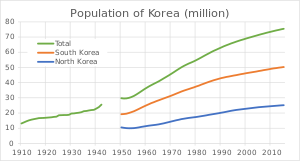| Demographics of South Korea | |
|---|---|
 Population pyramid of South Korea in 2023 | |
| Population | 51,430,018 (2023 est.) |
| Growth rate | 0.24% (2022 est.) |
| Birth rate | 4.5 births/1,000 population (2023 est.) |
| Death rate | 6.9 deaths/1,000 population (2023 est.) |
| Life expectancy | 82.97 years |
| • male | 79.88 years |
| • female | 86.24 years (2022 est.) |
| Fertility rate | 0.72 children born/woman (2023)[1] |
| Infant mortality rate | 2.87 deaths/1,000 live births |
| Net migration rate | 2.63 migrant(s)/1,000 population (2022 est.) |
| Age structure | |
| 0–14 years | 11.53% |
| 15–64 years | 70.09% |
| 65 and over | 18.38% |
| Sex ratio | |
| Total | 1.01 male(s)/female (2022 est.) |
| At birth | 1.05 male(s)/female |
| Under 15 | 1.05 male(s)/female |
| 65 and over | 0.6 male(s)/female |
| Nationality | |
| Nationality | Korean |
| Major ethnic | Koreans (homogenous)[2] |
| Language | |
| Spoken | Korean |

Demographic features of the population of South Korea include population density, ethnicity, education level, health of the populace, economic status, religious affiliations, and other aspects of the population. The common language and especially race are viewed as important elements by South Koreans in terms of identity, more than citizenship.
In June 2012, South Korea's population reached 50 million,[3] and by the end of 2016, South Korea's population peaked at about 51 million people.[4] However, in recent years the total fertility rate (TFR) of South Korea has plummeted, leading some researchers to suggest that if current trends continue, the country's population will shrink to approximately 28 million people by the end of the 21st century.[5] In 2018, fertility in South Korea became a topic of international debate after only 26,500 babies were born in October and an estimated 325,000 babies for the year, causing the country to achieve the lowest birth rate in the world.[6][7][8] In a further indication of South Korea's dramatic decline in fertility, in 2020 the country recorded more deaths than births, resulting in a population decline for the first time since modern records began.[9][10]
Analysts have attributed South Korea's population decline resulting from low birth rates to the country's high economic inequality; including the high cost of living, low wages for an OECD member country, lack of job opportunities, as well as rising housing costs.[11] South Korea also has the highest suicide rate in the OECD and the wider developed world.[12]



In South Korea, a variety of different Asian people had migrated to the Korean Peninsula in past centuries, however few have remained permanently. South Korea is a highly homogenous nation, but has in recent decades become home to a number of foreign residents (4.37%), whereas North Korea has not experienced this trend. However, many of them are ethnic Koreans with a foreign citizenship. Many residents from China, post-Soviet states, the United States and Japan are, in fact, repatriated ethnic Koreans (labelled "Overseas Koreans") who may meet criteria for expedited acquisition of South Korean citizenship.[13] For example, migrants from China (PRC) make up 56.5% of foreign nationals, but approximately 70% of the Chinese citizens in Korea are Joseonjok (조선족), PRC citizens of Korean ethnicity.[14] The total population of Korea is estimated to be 80 million, which includes the population of North Korea.[15]
- ^ Lee, Jaemin (29 January 2024). "South Korea's birth rate has become a national emergency". Financial Times.
- ^ "Korea, South", The World Factbook, Central Intelligence Agency, 2022-11-14, retrieved 2022-11-22
- ^ "South Korea's population passes 50 million". June 22, 2012. Archived from the original on 2018-07-04.
{{cite web}}: CS1 maint: unfit URL (link) - ^ "Population, total | Data". data.worldbank.org. Archived from the original on 2019-05-28. Retrieved 2018-04-12.
- ^ World Population Prospects 2019 Archived 2019-08-29 at the Wayback Machine by the United Nations, DESA, Population Division.
- ^ "S. Korea's childbirth tally drops to another historic low in October …". archive.fo. 2019-01-23. Archived from the original on 2019-01-23. Retrieved 2019-01-23.
- ^ "South Korea's fertility rate is the lowest in the world". The Economist. 2018-06-30. ISSN 0013-0613. Archived from the original on 2019-01-23. Retrieved 2019-01-23.
- ^ "Fertility rate dips below 1 in 2018: official". archive.fo. 2019-01-30. Archived from the original on 2019-01-30. Retrieved 2019-01-30.
- ^ Gladstone, Rick (4 January 2021). "As Birthrate Falls, South Korea's Population Declines, Posing Threat to Economy". New York Times. Archived from the original on 2021-01-04. Retrieved 2021-01-05.
- ^ "South Korea is facing a crisis of extinction and it's not due to North's nukes". The Economic Times. 5 January 2021.
- ^ Ryall, Julian (21 December 2021). "What's behind South Korea's population decline?". DW. Retrieved 23 March 2022.
- ^ Evans, Stephen (5 November 2015). "Korea's hidden problem: Suicidal defectors". BBC News. United Kingdom of Great Britain and Northern Ireland: British Broadcasting Corporation. Archived from the original on 2 June 2016. Retrieved May 17, 2016.
South Korea consistently has the highest suicide rate of all the 34 industrialized countries in the OECD.
- ^ Kwon, Jessie Yeung, Jake (2023-05-15). "They left South Korea for the American Dream. Now their children are moving back". CNN. Retrieved 2023-12-04.
{{cite web}}: CS1 maint: multiple names: authors list (link) - ^ "More Than 1 Million Foreigners Live in Korea (According to the article, approximately 443,566 people are considered to be Chinese residents in South Korea with Korean ethnicity.)". The Chosun Ilbo. 6 August 2009. Archived from the original on 9 September 2009. Retrieved 18 October 2009.
- ^ "Panmunjom Declaration for Peace, Prosperity and Unification of the Korean Peninsula". Reuters. 2018-04-27.